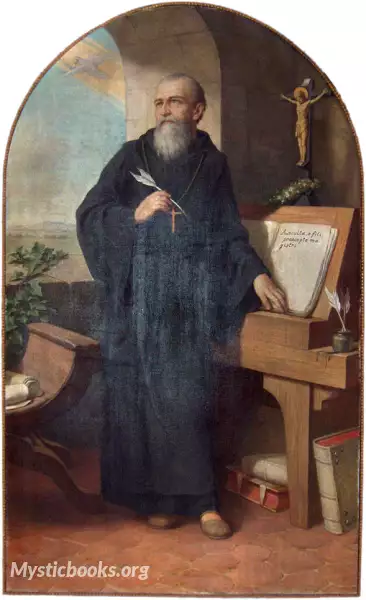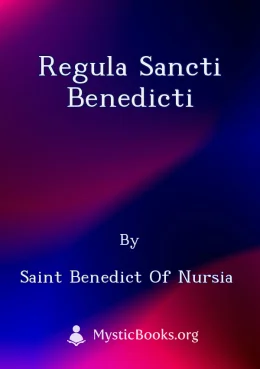
Timeline
Title
Country/Nationality
Saint Benedict of Nursia
Benedict of Nursia OSB is a Christian saint venerated in the Catholic Church, the Eastern Orthodox Church, the Oriental Orthodox Churches, the Anglican Communion and Old Catholic Churches. He is a patron saint of Europe.
All things – eating, drinking, sleeping, reading, working, and praying – should be done in moderation.
Benedict founded twelve communities for monks at Subiaco, Lazio, Italy before moving to Monte Cassino in the mountains of southern Italy. The Order of Saint Benedict is of later origin and, moreover, not an "order" as commonly understood but merely a confederation of autonomous congregations.
Benedict's main achievement, his "Rule of Saint Benedict", contains a set of rules for his monks to follow. Heavily influenced by the writings of John Cassian, it shows strong affinity with the Rule of the Master, but it also has a unique spirit of balance, moderation and reasonableness (ἐπιείκεια, epieíkeia), which persuaded most Christian religious communities founded throughout the Middle Ages to adopt it. As a result, his Rule became one of the most influential religious rules in Western Christendom. For this reason, Giuseppe Carletti regarded Benedict as the founder of Western Christian monasticism.
Apart from a short poem attributed to Mark of Monte Cassino, the only ancient account of Benedict is found in the second volume of Pope Gregory I's four-book Dialogues, thought to have been written in 593, although the authenticity of this work is disputed.
Gregory's account of Benedict's life is not, however, a biography in the modern sense of the word. It provides instead a spiritual portrait of the gentle, disciplined abbot. In a letter to Bishop Maximilian of Syracuse, Gregory states his intention for his Dialogues, saying they are a kind of floretum of the most striking miracles of Italian holy men.
Gregory did not set out to write a chronological, historically anchored story of Benedict, but he did base his anecdotes on direct testimony. To establish his authority, Gregory explains that his information came from what he considered the best sources: a handful of Benedict's disciples who lived with him and witnessed his various miracles. These followers, he says, are Constantinus, who succeeded Benedict as Abbot of Monte Cassino, Honoratus, who was abbot of Subiaco when St Gregory wrote his Dialogues, Valentinianus, and Simplicius.
In Gregory's day, history was not recognised as an independent field of study; it was a branch of grammar or rhetoric, and historia was an account that summed up the findings of the learned when they wrote what was, at that time, considered history. Gregory's Dialogues, Book Two, then, an authentic medieval hagiography cast as a conversation between the Pope and his deacon Peter, is designed to teach spiritual lessons.
Gregory tells us little of these years. He now speaks of Benedict no longer as a youth, but as a man of God. Romanus, Gregory tells us, served Benedict in every way he could. The monk apparently visited him frequently, and on fixed days brought him food.
During these three years of solitude, broken only by occasional communications with the outer world and by the visits of Romanus, Benedict matured both in mind and character, in knowledge of himself and of his fellow-man, and at the same time he became not merely known to, but secured the respect of, those about him; so much so that on the death of the abbot of a monastery in the neighbourhood (identified by some with Vicovaro), the community came to him and begged him to become its abbot. Benedict was acquainted with the life and discipline of the monastery, and knew that "their manners were diverse from his and therefore that they would never agree together: yet, at length, overcome with their entreaty, he gave his consent" . The experiment failed; the monks tried to poison him. The legend goes that they first tried to poison his drink. He prayed a blessing over the cup and the cup shattered. Thus he left the group and went back to his cave at Subiaco. There lived in the neighborhood a priest called Florentius who, moved by envy, tried to ruin him. He tried to poison him with poisoned bread. When he prayed a blessing over the bread, a raven swept in and took the loaf away. From this time his miracles seem to have become frequent, and many people, attracted by his sanctity and character, came to Subiaco to be under his guidance. Having failed by sending him poisonous bread, Florentius tried to seduce his monks with some prostitutes. To avoid further temptations, in about 530 Benedict left Subiaco. He founded 12 monasteries in the vicinity of Subiaco, and, eventually, in 530 he founded the great Benedictine monastery of Monte Cassino, which lies on a hilltop between Rome and Naples.
During the invasion of Italy, Totila, King of the Goths, ordered a general to wear his kingly robes and to see whether Benedict would discover the truth. Immediately Benedict detected the impersonation, and Totila came to pay him due respect.
Books by Saint Benedict of Nursia

The Rule of St. Benedict
The Rule of Saint Benedict (Regula Benedicti) is a book of precepts written by St. Benedict of Nursia for monks living communally under the authority of an abbot. Since about the 7th century it has also been adopted by communities of women. During th...

Regula Sancti Benedicti
The Rule of Saint Benedict, also known as Regula Benedicti, is a comprehensive guide for monastic life written by Saint Benedict of Nursia in the 6th century. It outlines a structured way of living in community, emphasizing prayer, work, and spiritua...